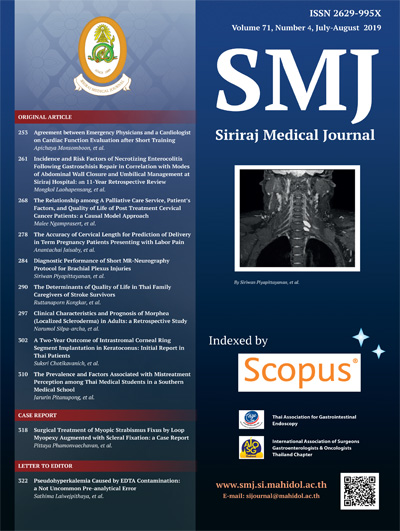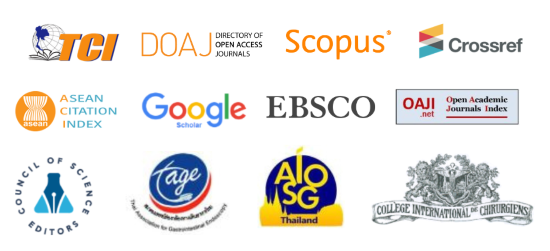A Two-Year Outcome of Intrastromal Corneal Ring Segment Implantation in Keratoconus: Initial Report in Thai Patients
Keywords:
Intrastromal corneal ring segment; keratoconus; ThailandAbstract
Objective: To determine two-year outcome of intrastromal corneal ring segment (ICRS) implantation in keratoconus in Thai patients
Methods: A retrospective review of medical records of the patients underwent Ferrara-type ICRS implantation (single and two segments) at Siriraj Hospital between November 2013 and December 2017 was conducted. Clinical outcomes were assessed at 1 month, 6 months, 1 year, and 2 years postoperatively.
Results: Of 9 eyes in 8 patients, the mean age of the patients was 24.6 ± 7.5 years. The mean follow-up time was 32.2 ± 9.4 months. Overall, the median visual acuity was significantly improved postoperatively (p value = 0.007). At 2 years, the uncorrected visual acuity (UCVA) improved from 1.00 logMAR to 0.56 logMAR, and the corrected
distance visual acuity (CDVA) improved from 0.76 logMAR to 0.10 logMAR. Correspondingly, the median spherical equivalent refraction was significantly improved postoperatively from -7.38 D to -3.13 D (p < 0.001). Moreover, the median anterior corneal topographic data significantly changed between visits (p < 0.02). The Kmax decreased from 52.65 D to 46.65 D and the Kmean decreased from 48.10 D to 45.40 D at 2 years. Postoperative adverse effects were glare and halos (3 eyes), visually insignificant small white corneal deposits around the segments (2 eyes), extrusion of a ring segment needed removal with reversible to baseline vision (1 eye).
Conclusion: This initial report in Thai patients showed that the ICRS implantation in keratoconus could improve the visual, refractive, and topographic parameters with stability at 2 years. However, appropriate case selection and surgical technique should be considered.
Downloads
Published
How to Cite
Issue
Section
License
Users are free to share, copy, and redistribute all articles published in the Siriraj Medical Journal (SMJ) in any medium or format as long as you follow the following terms:
- Attribution — You must give appropriate credit, provide a link to the material, and indicate if changes were made. You may do so in any reasonable manner, but not in any way that suggests the publisher endorses you or your use.
- NonCommercial — You may not use the material for commercial purposes.
- NoDerivatives — If you remix, transform, or build upon the material, you may not distribute the modified material.
- No additional restrictions — You may not apply legal terms or technological measures that legally restrict others from doing anything the license permits.







